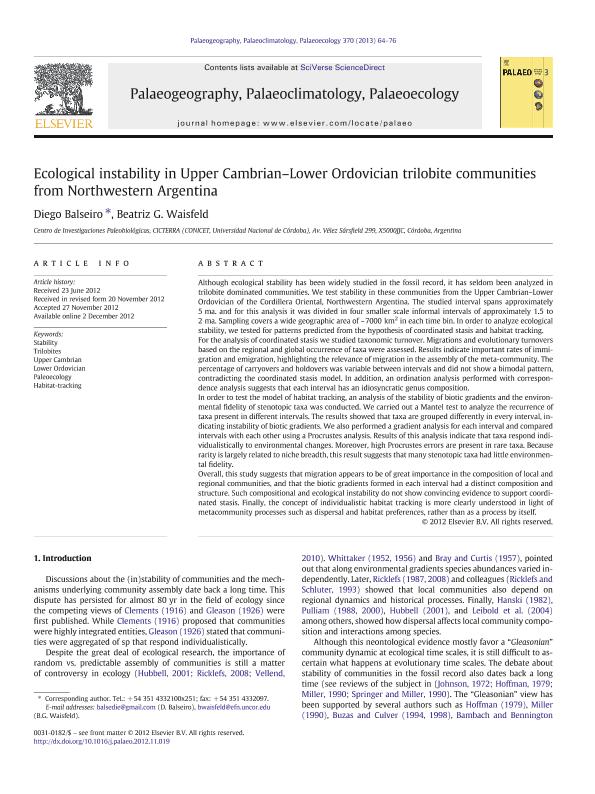Mostrar el registro sencillo del ítem
dc.contributor.author
Balseiro, Diego

dc.contributor.author
Waisfeld, Beatriz Graciela

dc.date.available
2017-10-05T21:28:54Z
dc.date.issued
2012-12
dc.identifier.citation
Balseiro, Diego; Waisfeld, Beatriz Graciela; Ecological instability in Upper Cambrian-Lower Ordovician trilobite communities from Northwestern Argentina; Elsevier Science; Palaeogeography, Palaeoclimatology, Palaeoecology; 370; 12-2012; 64-76
dc.identifier.issn
0031-0182
dc.identifier.uri
http://hdl.handle.net/11336/26051
dc.description.abstract
Although ecological stability has been widely studied in the fossil record, it has seldom been analyzed in trilobite dominated communities. We test stability in these communities from the Upper Cambrian–Lower Ordovician of the Cordillera Oriental, Northwestern Argentina. The studied interval spans approximately 5 ma. and for this analysis it was divided in four smaller scale informal intervals of approximately 1.5 to 2 ma. Sampling covers a wide geographic area of ~ 7000 km2 in each time bin. In order to analyze ecological stability, we tested for patterns predicted from the hypothesis of coordinated stasis and habitat tracking. For the analysis of coordinated stasis we studied taxonomic turnover. Migrations and evolutionary turnovers based on the regional and global occurrence of taxa were assessed. Results indicate important rates of immigration and emigration, highlighting the relevance of migration in the assembly of the meta-community. The percentage of carryovers and holdovers was variable between intervals and did not show a bimodal pattern, contradicting the coordinated stasis model. In addition, an ordination analysis performed with correspondence analysis suggests that each interval has an idiosyncratic genus composition. In order to test the model of habitat tracking, an analysis of the stability of biotic gradients and the environmental fidelity of stenotopic taxa was conducted. We carried out a Mantel test to analyze the recurrence of taxa present in different intervals. The results showed that taxa are grouped differently in every interval, indicating instability of biotic gradients. We also performed a gradient analysis for each interval and compared intervals with each other using a Procrustes analysis. Results of this analysis indicate that taxa respond individualistically to environmental changes. Moreover, high Procrustes errors are present in rare taxa. Because rarity is largely related to niche breadth, this result suggests that many stenotopic taxa had little environmental fidelity. Overall, this study suggests that migration appears to be of great importance in the composition of local and regional communities, and that the biotic gradients formed in each interval had a distinct composition and structure. Such compositional and ecological instability do not show convincing evidence to support coordinated stasis. Finally, the concept of individualistic habitat tracking is more clearly understood in light of metacommunity processes such as dispersal and habitat preferences, rather than as a process by itself.
dc.format
application/pdf
dc.language.iso
eng
dc.publisher
Elsevier Science

dc.rights
info:eu-repo/semantics/openAccess
dc.rights.uri
https://creativecommons.org/licenses/by-nc-nd/2.5/ar/
dc.subject
Paleoecologia
dc.subject
Trilobites
dc.subject
Cambro-Ordovícico
dc.subject
Cordillera Oriental
dc.subject.classification
Oceanografía, Hidrología, Recursos Hídricos

dc.subject.classification
Ciencias de la Tierra y relacionadas con el Medio Ambiente

dc.subject.classification
CIENCIAS NATURALES Y EXACTAS

dc.title
Ecological instability in Upper Cambrian-Lower Ordovician trilobite communities from Northwestern Argentina
dc.type
info:eu-repo/semantics/article
dc.type
info:ar-repo/semantics/artículo
dc.type
info:eu-repo/semantics/publishedVersion
dc.date.updated
2017-10-05T20:38:31Z
dc.journal.volume
370
dc.journal.pagination
64-76
dc.journal.pais
Países Bajos

dc.journal.ciudad
Amsterdam
dc.description.fil
Fil: Balseiro, Diego. Consejo Nacional de Investigaciones Científicas y Técnicas. Centro Científico Tecnológico Conicet - Córdoba. Centro de Investigaciones en Ciencias de la Tierra. Universidad Nacional de Córdoba. Facultad de Ciencias Exactas Físicas y Naturales. Centro de Investigaciones en Ciencias de la Tierra; Argentina
dc.description.fil
Fil: Waisfeld, Beatriz Graciela. Consejo Nacional de Investigaciones Científicas y Técnicas. Centro Científico Tecnológico Conicet - Córdoba. Centro de Investigaciones en Ciencias de la Tierra. Universidad Nacional de Córdoba. Facultad de Ciencias Exactas Físicas y Naturales. Centro de Investigaciones en Ciencias de la Tierra; Argentina
dc.journal.title
Palaeogeography, Palaeoclimatology, Palaeoecology

dc.relation.alternativeid
info:eu-repo/semantics/altIdentifier/doi/http://dx.doi.org/10.1016/j.palaeo.2012.11.019
dc.relation.alternativeid
info:eu-repo/semantics/altIdentifier/url/http://www.sciencedirect.com/science/article/pii/S003101821200661X
Archivos asociados
